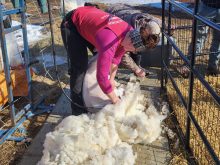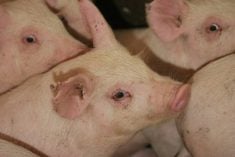One of the most phenomenal stories of growth in North American agriculture has occurred in Alberta during the last 30 years.
All of it is due to widespread expansion of the livestock industry.
“Someone tell me something that has changed as much in the last 30 years or is as vibrant as the Alberta industry,” said industry analyst Kevin Grier, of the George Morris Centre based in Guelph, Ont.
This province has taken over the business of feeding the country’s cattle as well as the packing and processing industry. Consequently this powerful industry leads the way in determining price.
Read Also

Charges laid after cattle theft
Saskatchewan RCMP lay two charges against a man after six cattle went missing.
In 1989 Alberta handled 45 percent of the Canadian kill; in 1999 it controlled 67 percent of the national slaughter. Cargill Foods at High River, Alta., and Lakeside-IBP at Brooks, Alta., are responsible for 60 percent of the Canadian slaughter now totaling more than 70,000 head a week.
However, that success is being undermined by the continued downturn in consumers’ desire for beef and beef’s quest for more of a smaller share of retail dollars.
“What we ultimately want is what the chicken guy has. More consumption at higher prices,” Grier told the directors of four purebred beef associations who gathered in Calgary to talk beef improvement.
“If you have to lower your price to move product, that’s not necessarily a good thing,” he said.
The cow-calf operator takes the biggest hit as the price decline continues. Part of that is demonstrated by fewer beef farms. In 1971 there were 36,000 farms raising cattle. In 1996 there were 32,000 farms. Growth occurred at already-large outfits, said Grier.
Lower demand for beef has also less money for the producer.
If 1998 demand equaled 1991 levels, 500 pound-calves in Alberta would have been worth $133 per hundredweight compared to the real price of $121 per cwt. last fall. A fed steer would sell for $91 per cwt. instead of $83.
“It hasn’t been a lot of fun in the last 15 years, regardless of where you are in the cattle cycle,” Grier said.
The industry has remained focused on cost reduction rather than product development or betterment of the animal.
“The cattle boys, all they can talk about is killing cheaper. Chicken talks about product.”
The beef industry will likely split, he predicted. One path may pursue large scale production where operators depend on volume and economies of scale. Others may choose the high quality niche market.
Several factors are affecting beef sales.
Changes on the retail side where large chains are gobbling up smaller ones give retailers greater pricing control. For example, Loblaws had 17 percent of the Canadian retail market in 1994. Today, it holds 32 percent, which gives it tremendous buying power.
Stable prices
Retailers prefer to keep prices stable because grocery shoppers don’t want to see prices swing wildly.
Store owners also know beef is a big ticket item and is worth promoting. Shoppers picking up a few items at a store are likely to spend about $20. If beef is added to the cart, the bill rings up to $70 on average, said Grier.
Retailers plan their sales features four to six weeks in advance. They receive daily price lists from packers and know the inventory of beef and other competing meats.
Packers negotiate privately with retailers. They calculate costs of killing, fabricating and keeping inventory when determining a price for the retailer. When packers are pricing cattle, they look at meat cutout values, byproduct values, inventory and live supplies.
A feeder buying calves uses a formula that includes cost of gain, cost of cattle and packer position.
However, in the real world, formulas are often set aside when the cattle feeder considers how much money he has to spend and how many pens he needs to fill.
Prices for feeder calves are the highest since 1993 and Grier predicts December and January are going to rise above the five-year average. Slaughter numbers of 70,000 per week should start to drop because fewer animals are available due to high heifer kills in the last three years.
Demand should remain healthy and feedlot operators should have some leverage in the coming year when selling their fat cattle.
“We’ve got a mammoth packing industry that demands to be fed,” Grier said.
He predicts the Alberta price for the first quarter of 2000 will be $93 per cwt. on fat cattle. The second quarter should go up to $97, falling back to $91 in the third quarter and the year could close out at $97.

















